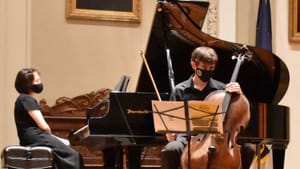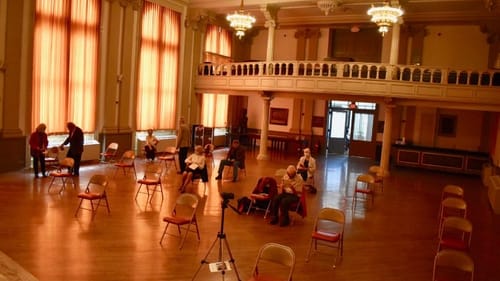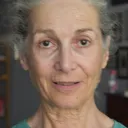Stay in the Loop
BSR publishes on a weekly schedule, with an email newsletter every Wednesday and Thursday morning. There’s no paywall, and subscribing is always free.
How does a concert on video compare to a live one?
The German Society of Pennsylvania presents Natalie Zhu and Clancy Newman

Cellist Clancy Newman and pianist Natalie Zhu, in concert at the German Society of Pennsylvania, offered an intriguing mix of compositions by Johannes Brahms, two Curtis graduates, and a contemporary composer/violist. A live, distanced performance at Spring Garden Street’s Barthelmes Auditorium was capped at 25 people (including the musicians), and a video of the concert went out to ticket-buyers. I set out to hear how the two versions of the performance compare.
In conversation
Samuel Barber’s 1936 Sonata for cello and piano, Opus 6, is a stellar work which he began while a student. Zhu and Newman played the rising intervals of the theme as if it were a conversation between cello and piano, each instrument clearly audible through the gamut of dynamic ranges—a feat when pairing a cello with a piano. Zhu worked miracles with the soft action of the Börsendorfer, playing both pianissimo and well-shaped louder sections without sounding harsh or overwhelming the cello. Their ability to imitate each other in intensity and phrasing was remarkable.
As for the recording of the Barber, it comes across quite well, but a microphone cannot reproduce the full sound of a live concert in a resonant room. The balance is still good, with rich, full chords of the piano over which the cello can be heard easily. I have listened to several recordings of this piece, but I prefer this video to all of them, especially the high single notes from the piano sprinkling over the sustained cello notes and dwindling in volume as Newman mimics the piano sound’s decay on the cello. In the third movement, they emulate each other’s articulation, blending the cello pizzicato with the piano’s staccato response. This is clear on the video as well, if not as striking.
Folksy expression
The Capriccio (1946) by Lukas Foss starts with the cello accelerating like a train leaving the station, then moves to a hoedown and back to a bluegrassy duel between cello and piano. Foss was born in Berlin, arrived with his family to the US when he was 15, and quickly embraced American musical idioms while a student at Curtis. (Leonard Bernstein was a classmate.) Foss, like Barber, studied composition with Rosario Scalero.
The blend of the pedaled piano sounds with a pizzicato from the cello resounded through the spacious Barthelmes auditorium. Newman sent long trills to Zhu, who wrapped them into her phrasing. Even though it was written 54 years ago, the piece sounds contemporary. Of the four pieces, the Capriccio seems to work as well in the recorded version as it did live, perhaps because the essential folksy American expression is more prominent than the quality of the sound.
Delicate and wild
Newman’s flautando evoking a Japanese flute had me looking for a flutist on the stage during “III. Broken Verses,” the delicate third movement of Kenji Bunch’s Broken Music. Bunch wrote the piece as a commission from the Naumberg International Foundation, whose competition Newman won in 2001. Although the flautando harmonics can be heard in the recording, the effect was not as startling as during the live concert. You can still hear the delicacy of the Satie-like harmonies in the recording.

The concert ended with Johannes Brahms’s 1865 Sonata No. 1 in E minor for Cello and Piano, Opus 38. Brahms, a pianist himself, wrote this sonata intending the piano to be more than background—he wanted it to be an equal partner. The formidable task of balance, timing, and imitation was achieved beautifully, especially in the final chord of the first movement, where the cello plays the third of the sustained E major final chord while the piano plays the root and tonic. The exchange of phrases was artfully articulated in the quasi-fugal themes and hemiolas that Brahms wove into the trio of the second movement.
Zhu started off at high speed in the final movement, creating a wild ride which both musicians made extremely exciting, but the clarity and balance suffered a bit. And yet, it was electric for the audience. The musicians re-recorded the third movement of the Brahms for the video. They still played at a good clip, but with more control, highlighting the incredible fugato inspired by the Contrapunctus XII of Johann Sebastian Bach’s The Art of the Fugue.
Something magic
I have listened to the video of the third movement of the Brahms again and again, and it is my favorite of the entire concert. Perhaps it is because I heard the live version. (The video was available to attendees and advance ticket-buyers only.) There is something magic about a live performance in the intimacy and the sheer joy of the music. The video, recorded and edited by Ed Cohen, is quite good, but nothing can replace the experience of a live concert.
Editor’s note: While the pandemic continues, no BSR writer is required to attend events in person. We urge everyone in our community to assess the risks of indoor events, note proper precautions, and make the best choices for their own safety. Our coverage continues to center outdoor and digitally accessible events
Image description: A photo of Natalie Zhu, wearing a black dress and seated in profile at a grand piano; and Clancy Newman, dressed in black and poised to play his cello. Both musicians are wearing facemasks.
Image description: A pre-concert photo of the Barthelmes Auditorium, with 24 folding chairs, a few occupied by concert-goers, spaced out in six rows on the shiny wooden floor.
What, When, Where
The German Society of Pennsylvania presents Clancy Newman and Natalie Zhu. Samuel Barber, Sonata for Cello and Piano, Opus 6; Lukas Foss, Capriccio; Kenji Bunch, “III. Broken Verses” from Broken Music for Cello and Piano (2002); Johannes Brahms, Sonata No. 1 in E Minor for Cello and Piano, Opus 38. Clancy Newman, cello; Natalie Zhu, piano. October 4, 2020 at the German Society of Pennsylvania’s Barthelmes Auditorium, 611 Spring Garden Street, Philadelphia. www.germansociety.org or (215) 627-2332.
A video stream of the concert was available to attendees and advance ticket-buyers only.
The German Society is an ADA-compliant venue. The October 4 concert capacity was limited to 25 people including the performers. Masks were required, seats were distanced, and each member of the audience provided information for contact tracing.
Sign up for our newsletter
All of the week's new articles, all in one place. Sign up for the free weekly BSR newsletters, and don't miss a conversation.

 Margaret Darby
Margaret Darby